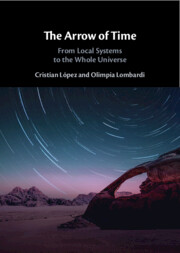Book contents
- The Arrow of Time
- The Arrow of Time
- Copyright page
- Contents
- Contributors
- Preface
- Acknowledgments
- Part I Local Systems
- Part II The Arrow of Time and Philosophical Issues
- Part III The Arrow of Time and Time-Reversal Invariance
- Part IV The Whole Universe
- 11 Following Earman’s Time Direction Heresy: From the Global Arrow of Time to Local Irreversible Processes
- 12 The Seeds of Cosmic Structure, the Black Hole Information Puzzle, and the Entropic Arrow of Time
- 13 Finding Time for Wheeler–DeWitt Cosmology
- Index
- References
11 - Following Earman’s Time Direction Heresy: From the Global Arrow of Time to Local Irreversible Processes
from Part IV - The Whole Universe
Published online by Cambridge University Press: 28 October 2025
- The Arrow of Time
- The Arrow of Time
- Copyright page
- Contents
- Contributors
- Preface
- Acknowledgments
- Part I Local Systems
- Part II The Arrow of Time and Philosophical Issues
- Part III The Arrow of Time and Time-Reversal Invariance
- Part IV The Whole Universe
- 11 Following Earman’s Time Direction Heresy: From the Global Arrow of Time to Local Irreversible Processes
- 12 The Seeds of Cosmic Structure, the Black Hole Information Puzzle, and the Entropic Arrow of Time
- 13 Finding Time for Wheeler–DeWitt Cosmology
- Index
- References
Summary
In a series of papers published during the last decades, with Mario Castagnino we developed a global and nonentropic approach to the arrow of time that follows John Earman’s “time direction heresy,” according to which the problem of the arrow of time can be addressed in terms of the geometry of space-time, independently of entropic arguments and without appealing to non–time-reversal invariance. The aim of this chapter is to present a review of the global and nonentropic approach to the arrow of time, and to consider some aspects that were not discussed in detail in those original works. In particular, it will be analyzed to what extent the arrow of time can still be defined if the conditions of time-orientability, cosmic time, and time-asymmetry are not satisfied. The role of time-reversal invariance in the present approach will also be discussed. Finally, certain issues about contingency, fundamentality, reducibility, and objectivity will be considered.
Information
- Type
- Chapter
- Information
- The Arrow of TimeFrom Local Systems to the Whole Universe, pp. 225 - 249Publisher: Cambridge University PressPrint publication year: 2025
References
Accessibility standard: WCAG 2.1 AA
Why this information is here
This section outlines the accessibility features of this content - including support for screen readers, full keyboard navigation and high-contrast display options. This may not be relevant for you.Accessibility Information
Content Navigation
Allows you to navigate directly to chapters, sections, or non‐text items through a linked table of contents, reducing the need for extensive scrolling.
Provides an interactive index, letting you go straight to where a term or subject appears in the text without manual searching.
Reading Order & Textual Equivalents
You will encounter all content (including footnotes, captions, etc.) in a clear, sequential flow, making it easier to follow with assistive tools like screen readers.
You get concise descriptions (for images, charts, or media clips), ensuring you do not miss crucial information when visual or audio elements are not accessible.
Visual Accessibility
You will still understand key ideas or prompts without relying solely on colour, which is especially helpful if you have colour vision deficiencies.
Structural and Technical Features
You gain clarity from ARIA (Accessible Rich Internet Applications) roles and attributes, as they help assistive technologies interpret how each part of the content functions.
